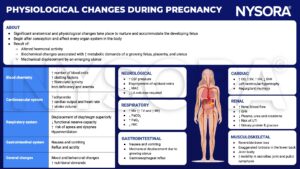Learning objectives
- Describe the major physiological changes during pregnancy
- Describe the anesthetic implications of the physiological changes during pregnancy
Background
- Every major organ system is affected by substantial physiological changes during pregnancy
- Many of these changes significantly affect the pharmacokinetic and pharmacodynamic properties of different therapeutic agents, including anesthetics
- Understanding these changes and their effects is essential to optimize therapy and anesthesia in obstetric patients
Physiological changes

CSF, cerebrospinal fluid; MAC, minimum alveolar concentration; LA, local anesthetic; MV, minute ventilation; TV, tidal volume; RR, respiratory rate; PaCO2, partial pressure of carbon dioxide; PaO2, partial pressure of oxygen; FRC, functional residual capacity; CO, cardiac output; SV, stroke volume; HR, heart rate; SVR, systemic vascular resistance; GFR, glomerular filtration rate; UTI, urinary tract infection
Anesthetic implications
| Cardiovascular | Uterine perfusion not autoregulated |
| Hypotension common under regional and general anesthesia | |
| Supine hypotensive syndrome requires left lateral tilt | |
| Respiratory | Potential hypoxemia in the supine and Trendelenburg positions |
| Breathing more diaphragmatic than thoracic | |
| Difficult laryngoscopy and intubation; bleeding during attempts | |
| Central nervous system | More extensive local anesthetic spread |
| Hematological | Dilutional anemia |
| Thromboembolic complications | |
| Edema, decreased protein binding of drugs | |
| Gastrointestinal | Increased aspiration risk |
| Antacid prophylaxis, RSI after 18 weeks gestation | |
| Renal | Normal urea and creatinine may mask impaired renal function |
| Glycosuria and proteinuria |
Suggested reading
- Costantine M. Physiologic and pharmacokinetic changes in pregnancy. Frontiers in Pharmacology. 2014;5.
- Nejdlova M, Johnson T. Anaesthesia for non-obstetric procedures during pregnancy. Continuing Education in Anaesthesia Critical Care & Pain. 2012;12(4):203-6.
We would love to hear from you. If you should detect any errors, email us [email protected]








